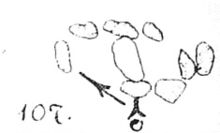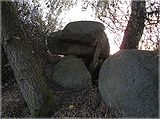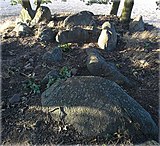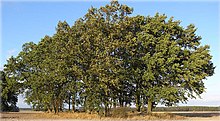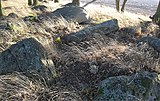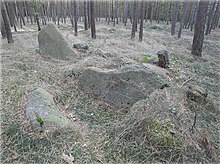Great stone graves near Leetze
| Great stone graves near Leetze | |||
|---|---|---|---|
|
View of the large stone graves Leetze 1–3 |
|||
|
|||
| Coordinates | Last 1 , Last 2 , Last 3 , Last 4 , Last 5 , Last 6 , Last 7 , Last 8 | ||
| place | Kuhfelde , Saxony-Anhalt , Germany | ||
| Emergence | 3700 to 3350 BC Chr. | ||
The megalithic graves near Leetze are a group of originally nine megalithic graves from the Neolithic deep- engraved ceramic culture near Leetze , a district of the municipality of Kuhfelde in the Altmarkkreis Salzwedel , Saxony-Anhalt . Of these, eight are largely preserved today. The ninth grave was destroyed in the 19th century. Three graves were archaeologically examined in 1938–39 under the direction of Ulrich Fischer .
location
The megalithic stone graves are located in Wötz, a desert near Leetze on an approx. 1100 m long, meridional line. Grave 1 is the northernmost preserved complex. Grave 2 is 140 m south of grave 1 and grave 3 another 60 m southeast. Grave 4 is 170 m south-southeast of grave 3 and grave 5 another 85 m south. Grave 6 follows again 360 m to the south. Grave 7 is 220 m south-southeast of this and grave 8 is finally another 80 m southwest.
According to investigations by Johann Friedrich Danneil in 1843, this line continued to the north and included another grave in Wötz, which was about 30 paces (approx. 23 m) northwest of grave 1, and at least seven graves in Wallstawe . However, these were already destroyed at the end of the 19th century.
3.1 km south-southwest of the graves near Leetze is the Bierstedt large stone grave .
Research history
The graves were first described in 1843 by Johann Friedrich Danneil. At the beginning of the 1890s, Eduard Krause and Otto Schoetensack found out when the large stone graves of the Altmark were taken again, that the northernmost grave near Leetze had been destroyed in the meantime. The remaining systems, however, were still in good condition. Some graves in the forest had been made accessible by the landowner through paths.
Grave 1 was about to be destroyed in 1938, but a report to the responsible authorities quickly led to archaeological investigations on graves 1 and 4 by the State Museum for Prehistory (at that time State Institute for Ethnology ) in Halle (Saale) under the direction of Ulrich Fischer, who ended with the reconstruction of grave 1. In the following year, grave 6 was also excavated and reconstructed.
In 2003-04, all remaining large stone graves in the Altmark were recorded and measured as a joint project of the State Office for Monument Preservation and Archeology of Saxony-Anhalt , the Johann Friedrich Danneil Museum in Salzwedel and the association “Young Archaeologists of the Altmark”.
There are different numbers for the graves. In the following, the site numbers are used for the graves that have been preserved, and the number for the destroyed graves with which Krause and Schoetensack provided it.
| official no. | Danneil (1843) | Krause / Schoetensack (1893) |
Beier (1991) | Remarks |
|---|---|---|---|---|
| - | D 70 | KS 106 | 1 | destroyed |
| Fpl. 1 | D 71 | KS 107 | 2 | receive |
| Fpl. 2 | D 72 | KS 108 | 3 | receive |
| Fpl. 3 | D 73 | KS 109 | 4th | receive |
| Fpl. 4 | D 74 | KS 110 | 5 | receive |
| Fpl. 5 | D 75 | KS 111 | 6th | receive |
| Fpl. 6 | D 76 | KS 112 | 7th | receive |
| Fpl. 7 | D 77 | KS 113 | 8th | receive |
| Fpl. 8 | D 78 | KS 114 | 9 | receive |
description
The preserved graves
Grave 1
Grave 1 is a large dolmen in the round hill. The burial mound consists of a rock fill; it has a diameter of 11 m and a height of 0.9 m. There is no edging. The chamber consisted of nine bearing stones, seven of which are still preserved, as well as three completely preserved capstones. A capstone was found outside the chamber during the 1938 excavation. Today only one capstone rests on the bearing stones. It measures 2.2 m × 1.0 m × 0.8 m. The spaces between the supporting stones were filled with sandstone slabs. The bearing stone on the northern narrow side is lower than the others and has a straight top. It forms the entrance to the interior of the chamber. The chamber is located in the center of the hill and is oriented north-south. It is rectangular and has internal dimensions 3.8 m × 1.4 m. Their height is 1.6–1.7 m.
Fischer discovered a careful paving of red sandstone in the chamber . Above it was a layer of ash that contained small fragments of bone (probably the remains of those buried) and several decorated shards. The latter can be assigned to deep-engraving ceramics . Above the ash layer followed by a layer of granite - Grus . On top of this lay the remains of deep-engraved ceramics, a flint ax and the remains of a skeleton which, according to recent radiocarbon studies, comes from a subsequent burial between 2400 and 2100 BC. And thus about 1000 years after the plant was built.
Grave 2
According to Hartmut Bock , Barbara Fritsch and Lothar Mittag, grave 2 is a large dolmen, according to Hans-Jürgen Beier, however, a large dolmen or a passage grave . The burial mound is oval and 0.8 m high. The grave border is oriented northwest-southeast; it has a length of 12.5 m and a width of 7 m. Originally it was probably oval in shape. Today 14 edging stones are still preserved. To the northwest of the border lie two overturned stones (presumably guardian stones ), one of which is at least 2 m high. They suggest that the edging may have been larger.
The burial chamber is also oriented northwest-southeast and lies in the northwest part of the enclosure. It originally consisted of ten bearing stones, eight of which have been preserved, and four cap stones, all of which have been preserved. The largest capstone measures 2.0 m × 1.1 m × 0.6 m. The chamber is rectangular and has internal dimensions 5.5 mx 1.7 m.
Grave 3
According to Hartmut Bock, Barbara Fritsch and Lothar Mittag, grave 3 is a large dolmen, but according to Hans-Jürgen Beier it is a large dolmen or a passage grave. The burial mound is elongated and has a height of 0.7 m. It was originally inside the enclosure but has now flowed beyond it. The grave border is oriented north-south; it has a length of 28.7 m and a width of 8.1–8.9 m. It is almost rectangular in shape and still consists of 33 stones that protrude between 1 m and 1.5 m from the ground. Two of them shattered. Guard stones stood at the corners of the enclosure. Three of them have been preserved. They are 2.8 m high. The fifth edging stone on the east side has two channels and two bowls .
The burial chamber is also oriented north-south and lies in the northern part of the enclosure. It originally consisted of 10 bearing stones and four cap stones, three of which are still preserved. The two largest cap stones measure 2.0 m × 1.0 m × 0.3 m or at least 1.9 m × 1.5 m × 0.5 m. The chamber is rectangular and has internal dimensions 6.8 m × 2.5 m.
Grave 4
According to Hartmut Bock, Barbara Fritsch and Lothar Mittag, grave 2 is a large dolmen, according to Hans-Jürgen Beier, however, a large dolmen or a passage grave. The burial mound consists of a bed of stones and is oval in shape. It is 11 m long and 8 m wide, its height is 0.5 m. The size and shape of the border cannot be determined as only two stones have survived. The burial chamber is oriented north-south. It originally consisted of 12 bearing stones (seven preserved) and five cap stones. Of the latter, three were still preserved during Fischer's excavations in 1938, now there are only two. The stones are made of gneiss and granite. The existing capstones measure 2.3 m × 1.5 m × 0.5 m or 1.7 m × 1.2 m × 0.5 m. The access to the interior of the burial chamber could not be clearly determined. Maybe it was in the middle of the west side. The chamber itself is pear-shaped and 6.4 m long. Their width varies between 1.4 m and 2.8 m. Its height was at least 1.3 m in 1938, today it is about 0.9 m.
As in grave 1, Fischer found sandstone paving in grave 4, but it was less carefully worked. Above it was again a layer of granite grit, on which some flint fragments and two poorly preserved human long bones were found.
Grave 5
According to Hartmut Bock, Barbara Fritsch and Lothar Mittag, grave 2 is a large dolmen, but according to Hans-Jürgen Beier it is a passage grave. The burial mound is elongated and has a height of 0.7 m. It was originally just inside the enclosure but has now flowed beyond it. The grave border is oriented north-north-west-south-south-east; it has a length of 24 m and a width of 5.0–6.5 m. It is trapezoidal and still has 34 of the original 37 stones. There are guard stones at the corners of the enclosure . Their dimensions are 2.5 m × 1.7 m × at least 0.8 m (SE corner), 3.0 m × 1.7 m × 0.8 m (SW corner), 2.1 m × 1 , 4 m × 0.7 m (NE corner) and 1.8 m height (NW corner, length and width cannot be determined).
The burial chamber is oriented north-northwest-south-southeast and is located in the southern part of the enclosure. It originally consisted of 14 or 15 wall stones, twelve of which have survived, and five or six cap stones, two of which have survived. The larger capstone measures 2.0 m × 1.8 m × 0.5 m. The chamber is rectangular and has the internal dimensions 7.0 m × 1.6 m.
The border of the grave is now divided into two sections by a stone bar. However, this bolt does not come from the time the tomb was built, but is of modern date.
Grave 6
Grave 6 represents one of the largest large stone graves in the Altmark . It belongs to the passage grave type . The burial mound has a height of 1.2 m. It was originally located within the north-south oriented enclosure but has now flowed beyond it. The trapezoidal edging is 37.5 m long and 4.5 by 7.5 m wide. It still has 48 of the original 50 kerbstones that reach a height of 0.5 to 2.5 m. There are guard stones at the corners of the enclosure . Their dimensions are 2.4 m × 1.55 m or 2.25 m × 1.2 m × 0.95 m on the north side and 2.3 m × 1.8 m × 0.9 m or on the south side 2.2 m high.
The also trapezoidal chamber is located west of the longitudinal axis, in the northern part of the enclosure. It originally consisted of 14 bearing stones and six cap stones, four of which have survived. The largest capstone measures 2.2 m × 1.1 m × 1.3 m. The cavities between the wall stones are filled with dry masonry . The chamber can be reached from the east side through an east-west oriented corridor. It is 3.0 m long, 0.7 m wide and between 0.9 m and 1.1 m high. It consists of three bearing stones and two cap stones. There was a locking stone towards the border and towards the chamber. The chamber is 7.5 m long and 1.0–1.5 m wide; their height is 1.4–1.5 m.
Fischer's examination of the grave revealed that the chamber was originally surrounded by an elongated earth dam, so that only the border and perhaps the upper edges of the capstones were visible from the outside. The corridor and chamber were laid out with several layers of field stones and granite gravel. Ceramic shards of deep engraving and spherical amphora culture , an amber bead , a spindle whorl and an arrowhead came to light.
Grave 7
Grave 7 is a passage grave according to Hartmut Bock, Barbara Fritsch and Lothar Mittag, Hans-Jürgen Beier classified it as a large stone grave of an indeterminable type. The burial mound is oriented northwest-southeast and oval. It is 15.0 m long, 11.5 m wide and 1.0 m high. A grave border could not be determined and possibly never existed. The burial chamber is oriented northwest-southeast. Ten wall stones and two cap stones have been preserved. The cap stones measure 1.9 m × 1.0 m × at least 0.3 m or at least 1.7 m × 1.3 m × 0.4 m. The burial chamber can be reached in the south-east corner through a corridor that is about 0.5 m wide and can only be recognized today by two parallel stones. The chamber itself is rectangular, 4.4 m long and 1.3 m wide.
Grave 8
According to Hartmut Bock, Barbara Fritsch and Lothar Mittag, grave 8 is an aisle grave, according to Hans-Jürgen Beier, however, a presumably extended dolmen . The burial mound is almost round and measures 14.0 m × 13.5 m. According to investigations by Eduard Krause and Otto Schoetensack in 1893, the grave was surrounded by an oval or round border, which has now been completely destroyed. The burial chamber is oriented north-south. Nine wall stones and two cap stones have survived. Another, blown-off fragment of a capstone is located 5 m outside the chamber. The largest capstone measures 1.7 m × 0.8 m × 0.5 m. Two parallel stones on the southeast corner possibly mark an entrance to the burial chamber with a width of 0.9 m. The chamber itself appears to be polygonal . It is 4.0 m long, 1.5 m wide and 0.7 m high.
The destroyed grave KS 106
Grave KS 106 had a burial chamber with a length of 6.3 m and a width of 3.1 m. When Danneil examined it, two cap stones were still preserved. To the south of the chamber there were still two guard stones of the original enclosure. Due to the size of the chamber, it must have been a large dolmen or a passage grave.
The megalithic graves near Leetze in regional legends
In an Altmark legend, a large stone grave in the Wötz desert is mentioned. The legend reports that a Frankish knight whom Charlemagne had sent to the Saxon Duke Widukind got lost in the desert and met a few turns there . They wanted to kill an old man. They explained to the knight that the man was their father, and because he could no longer work, they would kill him because it was their custom. Then they wanted to burn him and bury the urn in the large stone grave, next to the urn of a hero who was buried there a long time ago. The knight did not want to accept the killing. So he bought the old man free and made him gatekeeper of his castle.
See also
literature
- Hans-Jürgen Beier : The megalithic, submegalithic and pseudomegalithic buildings and the menhirs between the Baltic Sea and the Thuringian Forest (= contributions to the prehistory and early history of Central Europe. Volume 1). Wilkau-Haßlau 1991, p. 57.
- Wilhelm Blasius : Guide to the megalithic grave monuments in the western part of the Salzwedel district. In: Thirty-first annual report of the Altmark Association for Patriotic History and Industry. Issue 2, 1904, pp. 97-99 ( PDF; 8.1 MB ).
- Hartmut Bock , Barbara Fritsch, Lothar Mittag: Great stone graves of the Altmark. State Office for Monument Preservation and Archeology Saxony-Anhalt and State Museum for Prehistory, Halle (Saale) 2006, ISBN 3-939414-03-4 , pp. 91–113.
- Johann Friedrich Danneil : Special evidence of the barrows in the Altmark . In: Sixth annual report of the Altmark Association for Patriotic History and Industry . 1843, pp. 107-108, 120 ( PDF; 5.5 MB ).
- Hermann Dietrichs, Ludolf Parisius: Pictures from the Altmark. First and second volume. Hamburg 1883, p. 269 ( online ).
- Ulrich Fischer : Excavation and reconstruction of an endangered large stone grave in Wötz, Leetze municipality, Salzwedel district. In: Mitteldeutsche Volkheit. Booklets for prehistory, race and folklore. Volume 5, 1938, pp. 90-92.
- Ulrich Fischer: Investigations of large stone graves in the Altmark. In: 53rd annual report of the Altmark Association for Patriotic History in Salzwedel. 1939, pp. 3–8 ( PDF; 3.3 MB ).
- Ulrich Fischer: The Stone Age graves in the Saale area: Studies on Neolithic and Early Bronze Age grave and burial forms in Saxony-Thuringia. (= Prehistoric research. Volume 15). Berlin 1956, p. 68ff.
- Eduard Krause , Otto Schoetensack : The megalithic graves (stone chamber graves) of Germany . I .: Altmark . In: Journal of Ethnology . Vol. 25, 1893, p. 150 / no. 107-114, Plates VI / 107-111 and 114, VII / 107–111 ( PDF; 39.0 MB ).
- Teachers' Association of the Altmark (ed.): Altmärkischer Sagenschatz. Leipzig / Berlin 1908, p. 145.
- Johannes Müller : Radiocarbon chronology - ceramic technology - osteology - anthropology - spatial analysis. Contributions to the Neolithic and the Early Bronze Age in the Middle Elbe-Saale area. Part 1. In: Contributions of the Roman-Germanic Commission. Volume 80, 1999, p. 84.
- Joachim Preuss : The Altmark group of deep engraving ceramics (= publications of the State Museum for Prehistory in Halle. Volume 33). Deutscher Verlag der Wissenschaften, Berlin 1980, pp. 101-102.
- Britta Schulze-Thulin : Large stone graves and menhirs. Saxony-Anhalt • Thuringia • Saxony . Mitteldeutscher Verlag, Halle (Saale) 2007, ISBN 978-3-89812-428-7 , pp. 38-40.
Web links
- The Megalithic Portal: Grave 1 , Grave 2 , Grave 3 , Grave 4 , Grave 5 , Grave 6 , Grave 7 , Grave 8
- KLEKs Online: Grave 1 , Grave 2 , Grave 3 , Grave 4 , Grave 5 , Grave 6 , Grave 7 , Grave 8
- grosssteingraeber.de: Grave 1 , Grave 2 , Grave 3 , Grave 4 , Grave 5 , Grave 6 , Grave 7 , Grave 8
- tw.strahl.org: grave 1 , grave 2 , grave 3 , grave 4 , grave 5 , grave 6 , grave 7 , grave 8
Individual evidence
- ↑ Hartmut Bock, Barbara Fritsch, Lothar Mittag: Großsteingraves der Altmark. 2006, pp. 91-92.
- ↑ Hartmut Bock, Barbara Fritsch, Lothar Mittag: Großsteingraves der Altmark. 2006, p. 11.
- ↑ Hartmut Bock, Barbara Fritsch, Lothar Mittag: Großsteingraves der Altmark. 2006, p. 91.
- ↑ Hartmut Bock, Barbara Fritsch, Lothar Mittag: Großsteingraves der Altmark. 2006, p. 92.
- ↑ Hartmut Bock, Barbara Fritsch, Lothar Mittag: Großsteingraves der Altmark. 2006, p. 95.
- ↑ Hartmut Bock, Barbara Fritsch, Lothar Mittag: Großsteingraves der Altmark. 2006, pp. 98-99.
- ↑ Draw. J. Preuss 1980
- ↑ Hartmut Bock, Barbara Fritsch, Lothar Mittag: Großsteingraves der Altmark. 2006, p. 101.
- ↑ Hartmut Bock, Barbara Fritsch, Lothar Mittag: Großsteingraves der Altmark. 2006, p. 103.
- ↑ Hartmut Bock, Barbara Fritsch, Lothar Mittag: Großsteingraves der Altmark. 2006, pp. 104-105.
- ↑ Hartmut Bock, Barbara Fritsch, Lothar Mittag: Großsteingraves der Altmark. 2006, p. 105.
- ↑ Hartmut Bock, Barbara Fritsch, Lothar Mittag: Großsteingraves der Altmark. 2006, p. 107.
- ↑ Hartmut Bock, Barbara Fritsch, Lothar Mittag: Großsteingraves der Altmark. 2006, pp. 108-110.
- ↑ Hartmut Bock, Barbara Fritsch, Lothar Mittag: Großsteingraves der Altmark. 2006, p. 111.
- ↑ Hartmut Bock, Barbara Fritsch, Lothar Mittag: Großsteingraves der Altmark. 2006, p. 112.
- ↑ Hartmut Bock, Barbara Fritsch, Lothar Mittag: Großsteingraves der Altmark. 2006, pp. 92-94.



